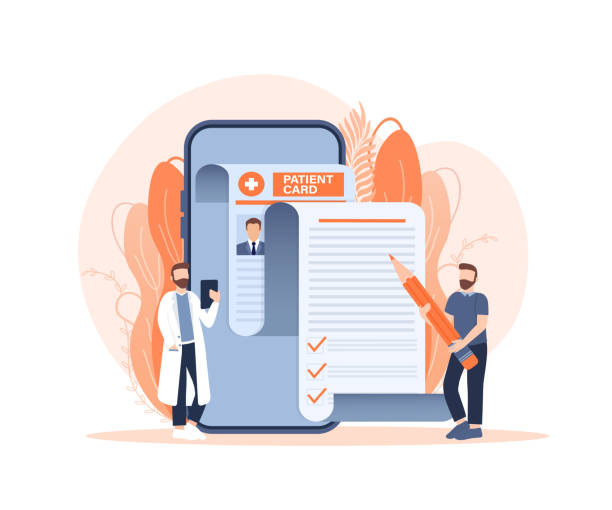What is Corporate Website Design and Why is it Crucial for Your Business?
![]()
In today’s digital world, a strong online presence is no longer an option, but a vital necessity for any business.
Corporate website design means creating a dedicated and professional platform on the web that represents a company’s identity, services, and products.
This site goes beyond acting as an online catalog; it serves as an information hub, a marketing tool, and a communication gateway with customers and business partners.
One of the most important reasons for needing #corporate_website_design is 24/7 access to your business information.
Potential customers can access you anytime, anywhere, ask questions, and get acquainted with your services.
This continuous access significantly increases sales and interaction opportunities.
Furthermore, a professional website enhances customer trust and credibility in your business.
Today’s users research companies before any interaction or purchase, and your website will be their first point of contact.
An outdated or unprofessional website can create a negative impression, while an up-to-date and user-friendly site showcases your professionalism.
Additionally, a corporate website is a powerful tool for #digital_marketing and #SEO, helping you to appear in search engine results and attract targeted traffic.
Investing in corporate website design is an investment in your business’s future and sustainable growth. This platform allows you to tell your brand’s story, introduce your services in detail, and establish a deeper connection with your audience, all of which significantly strengthen your market position.
Are you bothered by losing customers due to your online store’s outdated appearance or slow speed? Rasaweb’s expert team solves these problems with professional e-commerce website design!
✅ Increase customer trust and brand credibility
✅ Stunning speed and excellent user experience
Get a free consultation with Rasaweb now ⚡
Essential Features and Capabilities of a Successful Corporate Website

For a corporate website to achieve its business goals, it must possess a set of key features and capabilities.
The first and most important feature is Responsive Design.
Given the increasing use of mobile devices for web browsing, your website must display correctly and provide a flawless user experience across all screen sizes, from desktops to tablets and smartphones.
High loading speed is also of particular importance; users quickly leave slow-loading sites, and this can also harm your SEO ranking.
Another vital feature is an efficient Content Management System (CMS) that allows you to easily update and manage website content.
This is crucial for keeping company information, news, articles, and products up-to-date.
The website should have a clear and intuitive navigation structure so users can easily find the information they need.
Contact Us, About Us, Services, Products, and Blog sections are essential components of a standard corporate website.
Website security must also be a priority; using an SSL certificate (HTTPS) for data encryption and protection against cyber-attacks is a requirement.
Integration capabilities with digital marketing tools like Google Analytics, email newsletter tools, and social media are also necessary for monitoring performance and interacting with the audience.
A successful corporate website design should be able to reflect your brand’s visual identity, appear professional, and create an engaging and functional experience for visitors to convert them into loyal customers.
These elements together enhance a website’s potential to become a valuable asset for your business.
Step-by-Step Process of Professional Corporate Website Design
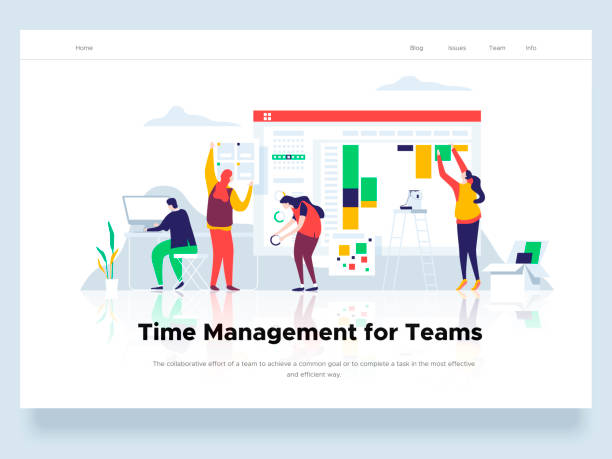
The process of corporate website design is a multi-stage journey, where each step is crucial for the project’s ultimate success.
The first stage is Analysis and Planning.
In this phase, business needs, target audience, site goals, and your competitors are thoroughly examined.
Defining content type, site structure (sitemap), and required functionalities are done at this stage.
The second stage is User Interface (UI) and User Experience (UX) Design.
In this section, wireframes and mockups are created to determine the overall look and feel of the site and how users will interact with it.
The focus is on simplicity, aesthetics, and user-friendliness.
After design approval, we move to the Development and Coding stage.
In this stage, designers and developers convert graphic designs into HTML, CSS, JavaScript codes, and server-side programming languages.
Database connection and CMS implementation are also performed in this step.
This process forms the foundation of any robust corporate website design.
The fourth stage is Content Creation and Optimization.
High-quality, engaging, and SEO-optimized content is produced for the site and placed in appropriate positions.
This content includes texts, images, videos, and any other visual elements that convey your brand message.
Finally, Site Testing and Launch takes place.
In this stage, the site is fully tested for performance, security, browser compatibility, and responsiveness, and after resolving any potential issues, it is uploaded to the server and publicly launched.
Continuous maintenance and updates are also essential for preserving the site’s optimal performance and security after launch.
This organized process ensures that your site is not only beautiful but also fully functional and effective.
| Stage | Description | Importance |
|---|---|---|
| Analysis and Planning | Defining goals, audience, content, and site structure. | Foundation of the project |
| UI/UX Design | Designing visual appearance and user experience (wireframes, mockups). | Attracting and retaining users |
| Development and Coding | Converting design to executable code, CMS implementation. | Creating the technical foundation of the site |
| Content Creation and Optimization | Writing texts, selecting images and videos, content SEO. | Conveying message and improving SEO |
| Testing and Launch | Checking performance, security, and compatibility, public release. | Ensuring quality and accessibility |
| Maintenance and Updates | Technical support, security updates, content addition. | Sustainable performance and long-term security |
Common Challenges in Corporate Website Design and Ways to Overcome Them
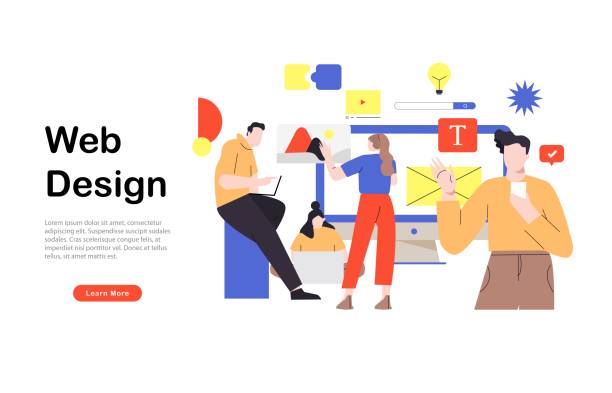
Despite countless benefits, the corporate website design process can come with challenges, and being aware of them and finding suitable solutions is key to project success.
One of the biggest challenges is determining a realistic and sufficient budget.
Many businesses don’t accurately estimate the costs of website design, development, content, and maintenance, which can lead to incomplete projects or low quality.
The solution is to consult with a reputable web design company from the start and establish a transparent and realistic budget that covers all aspects of the project.
Another challenge is choosing the right team or company for the design.
The market is full of agencies and freelancers, and discerning a professional team that can meet your business’s specific needs is difficult.
To overcome this challenge, carefully review previous portfolios, read client testimonials, and ensure transparency in communication and contracts.
Another common issue is producing high-quality, SEO-optimized content.
Many companies lack engaging or sufficient content for their website.
Hiring a professional copywriter or collaborating with SEO consultants can be very beneficial here.
Also, neglecting user experience (UX) and responsive design can lead to losing visitors.
Ensure your designer prioritizes these principles and optimizes the website for all devices.
Ignoring security and maintenance after launch is also a big mistake that can lead to cyber-attacks or website downtime.
A corporate website requires regular updates, backups, and security monitoring.
By anticipating these challenges and planning for them, you can make the most of your website design process and achieve your business goals.
Did you know that poor online store design can drive away up to 70% of your potential customers? Rasaweb transforms your sales with professional and user-friendly e-commerce website designs.
✅ Significant increase in sales and revenue
✅ Full optimization for search engines and mobile
⚡ [Get a free consultation from Rasaweb]
Investing in Corporate Website Design Yields Significant ROI
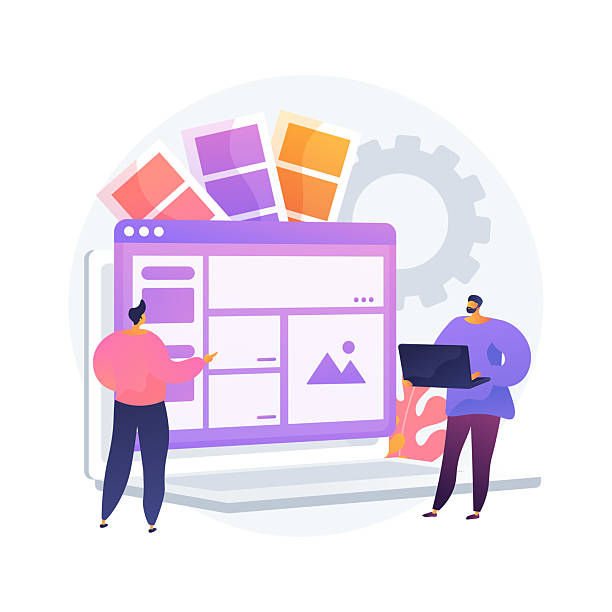
Investing in professional corporate website design is not just an expense, but a strategic investment with significant Return on Investment (ROI).
One of the most important ways a website ensures ROI is by increasing brand awareness and credibility.
An attractive and user-friendly site presents a professional image of your company and builds audience trust, directly leading to increased business opportunities.
A corporate website acts as a powerful 24-hour marketing tool.
By optimizing for search engines (SEO), your site can continuously attract organic and targeted traffic, which translates to potential leads and new customers, without the need for continuous advertising costs.
This approach is particularly crucial in corporate website design.
Reducing operational costs is another avenue for ROI.
For example, you can create a comprehensive Frequently Asked Questions (FAQ) section that answers many customer queries and reduces the workload of your support team.
Also, the ability to offer online services, download catalogs, or book appointments simplifies and streamlines processes.
Using analytical tools like Google Analytics, you can monitor user behavior and optimize your marketing strategies.
This data-driven approach helps you make more informed decisions and increase the return on your digital campaigns.
Finally, an efficient corporate website design provides access to new and global markets, without geographical limitations.
This market expansion can, by itself, lead to a significant increase in revenue and ROI, allowing companies to grow faster and achieve their long-term goals.
New Trends in Corporate Website Design You Should Know

The world of corporate website design is constantly evolving, and being aware of new trends can help companies create leading and attractive websites.
One of the most important current trends is the use of Artificial Intelligence (AI) and Machine Learning for personalizing the user experience.
Smart chatbots, content recommendations based on user behavior, and even AI-adaptive designs are all moving towards providing a unique experience for each visitor.
This personalization increases user engagement and improves conversion rates.
Also, minimalist design and simplicity (Minimalism) remain popular.
Focusing on white space, readable fonts, and removing unnecessary elements makes the main content stand out more and gives the site a modern and professional appearance.
The move towards Micro-interactions (small and subtle interactions) is also growing; such as small animations when clicking buttons or opening menus, which make the user experience more enjoyable.
The use of full-screen videos and animations in the site’s background is also increasing to immediately capture attention and convey the brand message.
These dynamic visual elements can tell the company’s story in a more engaging way.
Furthermore, a focus on Accessibility for all users, including those with disabilities, is growing.
Websites should be designed to be usable by assistive technologies.
Finally, emerging technologies like Virtual Reality (VR) and Augmented Reality (AR) are gradually making their way into corporate website design and have the potential to create completely immersive experiences.
Keeping pace with these trends can help your company stand out in today’s competitive market and move ahead of its rivals.
Choosing the Right Platform and Tools for Corporate Website Design
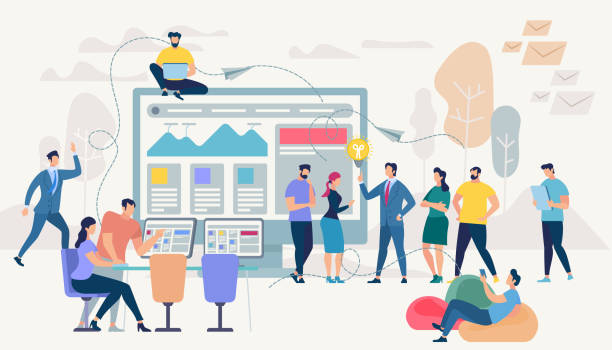
Choosing the right platform for corporate website design is one of the most important early decisions, as it impacts future capabilities, scalability, and maintenance costs.
There are numerous options, each with its own advantages and disadvantages.
WordPress is one of the most popular choices for corporate websites due to its high flexibility, large number of plugins and themes, and extensive user community.
This platform is suitable for companies with various budgets and diverse needs, providing easy content management.
However, for very large and complex projects, deeper customizations might be required.
Joomla and Drupal are other open-source content management systems that are better suited for larger websites with higher security requirements but demand more technical knowledge for development and management.
For companies that need completely custom solutions and infinite scalability, Custom Development using frameworks like React, Angular, Vue.js on the frontend and Node.js, Python, or PHP on the backend, is a suitable option.
Although this method is more costly and time-consuming, it offers unparalleled flexibility.
In addition to the platform, choosing the right hosting (web hosting) is also crucial.
High-quality hosting ensures fast website loading speed and protects data security.
Services like CDN (Content Delivery Network) can also optimize site speed for users in different parts of the world.
Finally, tools for web analytics (like Google Analytics), image optimization, and SEO management should also be considered to ensure the optimal performance of your corporate website.
These choices should be made carefully and based on your business’s real and long-term needs to ensure your corporate website design is sustainable and successful.
| Platform | Advantages | Disadvantages | Suitable for |
|---|---|---|---|
| WordPress | High flexibility, many plugins, large community, SEO-friendly. | Requires regular maintenance, potential vulnerabilities (with lack of updates). | Most businesses, from small to medium and large. |
| Joomla | Advanced user management, precise content control, suitable for portals. | More complex than WordPress, smaller community, fewer plugins. | Medium to large companies with specific structural needs. |
| Drupal | High security, excellent scalability, suitable for very large sites. | Requires specialized developer, higher cost. | Large organizations, governments, and universities. |
| Custom Development | Full flexibility, unique features, optimal performance. | High cost and time, requires in-house or contracted technical team. | Innovative startups, companies with specific and unique needs. |
SEO Strategies to Increase Your Corporate Website’s Visibility

Even the best corporate website design will get lost in the sea of the internet without strong SEO strategies.
SEO is a set of actions that help your website achieve a higher ranking in search engine results like Google and attract more organic (free) traffic.
The first step in SEO is Keyword Research.
You need to know what terms your target audience searches for to find your products or services.
These keywords should be strategically placed in the site’s content, page titles, meta descriptions, and URLs.
The second step is On-page SEO.
This includes creating high-quality, valuable content that answers users’ questions, proper use of heading tags (H1, H2, H3), image optimization with Alt Text, and ensuring a suitable navigation structure.
Website loading speed and responsiveness are also important SEO factors that improve user experience and are ranked by Google.
The third step is Technical SEO.
This includes items such as creating an XML Sitemap, Robots.txt file, using HTTPS for security, and ensuring proper indexing of pages by search engine robots.
The fourth step is Off-page SEO, which primarily focuses on building high-quality backlinks from reputable sites.
These links indicate to Google that your website is authoritative and trustworthy.
Finally, continuous analysis and monitoring of SEO performance with tools like Google Analytics and Google Search Console are essential to continuously improve your strategy.
With these measures, your corporate website will transform from just a beautiful storefront into a powerful magnet for attracting potential customers.
Research shows that 80% of customers trust companies with professional websites more. Does your current website inspire this trust?
With Rasaweb’s corporate website design services, solve the problem of low customer trust and poor online image forever!
✅ Create a professional image and increase customer trust
✅ Attract more sales leads and business growth
⚡ Get a free consultation
Successful Corporate Website Design Examples and Lessons to Learn
![]()
Examining successful corporate website design examples can be inspiring and provide valuable lessons for developing our own website.
Companies like Apple, Google, Microsoft, and Tesla all have websites that go beyond a simple online presence and have become an unparalleled user experience.
One common feature in these successful sites is simplicity and focus on the main message.
They utilize minimalist designs that allow visitors to quickly find the information they need, without being distracted by unnecessary elements.
Extensive use of white space, high-quality images, and readable fonts enhance visual appeal and user-friendliness.
Another important lesson is providing comprehensive information with a structured layout.
These sites effectively know how to present their complex products and services in simple and understandable language, using videos, infographics, and FAQ sections.
Furthermore, strong mobile experience support and full responsiveness are also prominent features of these sites.
They look great and perform flawlessly on any device.
Also, smart use of Call-to-Action (CTA) guides users towards business goals (such as purchasing, signing up, contacting).
These buttons are clearly visible and appealing.
Finally, continuous content and design updates to maintain freshness and relevance to market needs are fundamental principles that these companies adhere to.
These examples demonstrate that a successful corporate website design is the result of a combination of excellent visual design, flawless user experience, strategic content, and advanced technology, all harmonized with the goal of delivering value to the audience.
The Importance of Data Analysis and Continuous Optimization for Corporate Websites

After corporate website design and launch, your work has just begun.
To ensure your website achieves its business goals, data analysis and continuous optimization are critically important.
Tools like Google Analytics allow you to see who visits your site, where they come from, how long they stay, which pages they view, and what devices they use to access your site.
This information is invaluable and helps you gain a deeper understanding of your audience and their behavior.
By analyzing this data, you can identify your website’s strengths and weaknesses.
For example, if you notice that users leave the site after entering a specific page (high Bounce Rate), this could indicate a problem with the content, design, or loading speed of that page.
In such a case, you should make optimizations to improve that page.
A/B Testing is also an effective method for optimization.
In this method, two different versions of a page or an element (such as a title, image, or Call-to-Action button) are randomly shown to users, and the performance of each version is evaluated to determine which performs better.
This continuous optimization process helps you increase your site’s conversion rate (such as the number of leads, sales, or sign-ups).
The digital world is dynamic, and user behavior, search algorithms, and technologies are constantly changing.
Therefore, regular monitoring and updating of your corporate website are essential for maintaining competitiveness and long-term success.
With this approach, your website will not only remain alive and dynamic but also increase its efficiency and effectiveness over time.
Frequently Asked Questions
| Question | Answer |
|---|---|
| What is corporate website design? | The process of building a website for a company that represents its identity, products/services, and contact information. |
| Why do companies need a website? | To build credibility, increase visibility, provide information to customers, attract new clients, and facilitate communication. |
| What are the main features of a good corporate website? | Professional and user-friendly design, responsiveness (mobile-friendly), easy navigation, useful and accurate content, clear ‘Contact Us’ section. |
| What stages does the corporate website design process include? | Includes planning and needs analysis, graphic design and user experience (UI/UX), coding and implementation, content entry, testing, and launch. |
| What are the benefits of having a corporate website? | Improved brand image, 24/7 global access, reduced traditional marketing costs, increased customer trust, and a platform for online sales (if needed). |
And other services of Rasaweb Advertising Agency in the field of advertising
Sales Psychology Techniques in Medical Product Advertisements
How to Optimize Advertisements for Exporting Medical Products
The Role of Visual Content in the Success of Classified Ads
How to Use Market Data in Ad Placement
The Impact of Offering Warranty in Medical Product Advertisements
And over hundreds of other services in the field of online advertising, advertising consultation, and organizational solutions
Online Advertising | Advertising Strategy | Advertorials
🚀 Transform your business’s digital presence with Rasaweb’s internet advertising strategies and advertorials.
📍 Tehran, Mirdamad Street, next to Bank Markazi, Kazeroun Jonoubi Alley, Ramin Alley, No. 6

